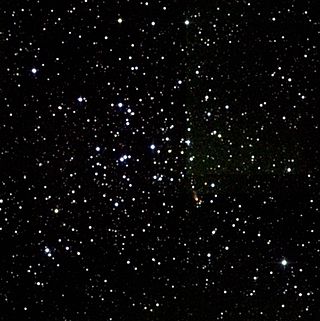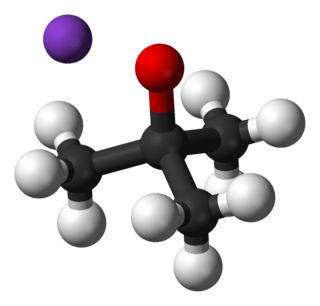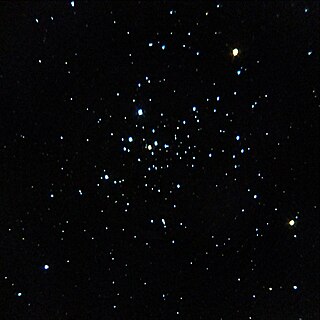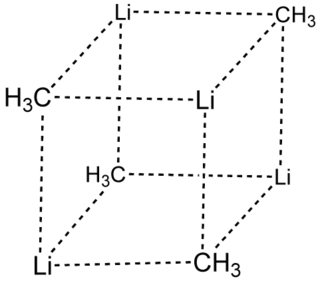Related Research Articles

Lithium is a chemical element with the symbol Li and atomic number 3. It is a soft, silvery-white alkali metal. Under standard conditions, it is the least dense metal and the least dense solid element. Like all alkali metals, lithium is highly reactive and flammable, and must be stored in vacuum, inert atmosphere, or inert liquid such as purified kerosene or mineral oil. It exhibits a metallic luster. It corrodes quickly in air to a dull silvery gray, then black tarnish. It does not occur freely in nature, but occurs mainly as pegmatitic minerals, which were once the main source of lithium. Due to its solubility as an ion, it is present in ocean water and is commonly obtained from brines. Lithium metal is isolated electrolytically from a mixture of lithium chloride and potassium chloride.

The Pleiades, also known as the Seven Sisters, Messier 45, and other names by different cultures, is an asterism and an open star cluster containing middle-aged, hot B-type stars in the north-west of the constellation Taurus. At a distance of about 444 light years, it is among the nearest star clusters to Earth. It is the nearest Messier object to Earth, and is the most obvious cluster to the naked eye in the night sky. It is also observed to house the reflection nebula NGC 1432, an HII region.
A tetraneutron is a hypothetical stable cluster of four neutrons. The existence of this cluster of particles is not supported by current models of nuclear forces. There is some empirical evidence suggesting that this particle does exist, based on a 2001 experiment by Francisco-Miguel Marqués and co-workers at the Ganil accelerator in Caen using a novel detection method in observations of the disintegration of beryllium and lithium nuclei. However, subsequent attempts to replicate this observation have failed.

A lithium-ion or Li-ion battery is a type of rechargeable battery which uses the reversible reduction of lithium ions to store energy. The negative electrode of a conventional lithium-ion cell is typically graphite, a form of carbon. This negative electrode is sometimes called the anode as it acts as an anode during discharge. The positive electrode is typically a metal oxide; the positive electrode is sometimes called the cathode as it acts as a cathode during discharge. Positive and negative electrodes remain positive and negative in normal use whether charging or discharging and are therefore clearer terms to use than anode and cathode which are reversed during charging.

In organometallic chemistry, organolithium reagents are chemical compounds that contain carbon–lithium (C–Li) bonds. These reagents are important in organic synthesis, and are frequently used to transfer the organic group or the lithium atom to the substrates in synthetic steps, through nucleophilic addition or simple deprotonation. Organolithium reagents are used in industry as an initiator for anionic polymerization, which leads to the production of various elastomers. They have also been applied in asymmetric synthesis in the pharmaceutical industry. Due to the large difference in electronegativity between the carbon atom and the lithium atom, the C−Li bond is highly ionic. Owing to the polar nature of the C−Li bond, organolithium reagents are good nucleophiles and strong bases. For laboratory organic synthesis, many organolithium reagents are commercially available in solution form. These reagents are highly reactive, and are sometimes pyrophoric.

Messier 36 or M36, also known as NGC 1960, is an open cluster of stars in the somewhat northern Auriga constellation. It was discovered by Giovanni Batista Hodierna before 1654, who described it as a nebulous patch. The cluster was independently re-discovered by Guillaume Le Gentil in 1749, then Charles Messier observed it in 1764 and added it to his catalogue. It is about 1,330 pc away from Earth. The cluster is very similar to the Pleiades cluster (M45), and if as far away it would be of similar apparent magnitude.

IC 2602 is an open cluster in the constellation Carina. Discovered by Abbe Lacaille in 1751 from South Africa, the cluster is easily visible to the unaided eye, and is one of the nearest star clusters, centred about 149 parsecs away from Earth.

IC 4756 is a large bright open cluster in the constellation Serpens. Known as Graff's Cluster, it is bright enough to be seen with the naked eye and considered a fine cluster for binoculars or small telescopes.

n-Butyllithium C4H9Li (abbreviated n-BuLi) is an organolithium reagent. It is widely used as a polymerization initiator in the production of elastomers such as polybutadiene or styrene-butadiene-styrene (SBS). Also, it is broadly employed as a strong base (superbase) in the synthesis of organic compounds as in the pharmaceutical industry.
Metal aromaticity or metalloaromaticity is the concept of aromaticity, found in many organic compounds, extended to metals and metal-containing compounds. The first experimental evidence for the existence of aromaticity in metals was found in aluminium cluster compounds of the type MAl−
4 where M stands for lithium, sodium or copper. These anions can be generated in a helium gas by laser vaporization of an aluminium / lithium carbonate composite or a copper or sodium / aluminium alloy, separated and selected by mass spectrometry and analyzed by photoelectron spectroscopy. The evidence for aromaticity in these compounds is based on several considerations. Computational chemistry shows that these aluminium clusters consist of a tetranuclear Al2−
4 plane and a counterion at the apex of a square pyramid. The Al2−
4 unit is perfectly planar and is not perturbed the presence of the counterion or even the presence of two counterions in the neutral compound M
2Al
4. In addition its HOMO is calculated to be a doubly occupied delocalized pi system making it obey Hückel's rule. Finally a match exists between the calculated values and the experimental photoelectron values for the energy required to remove the first 4 valence electrons. The first fully metal aromatic compound was a cyclogallane with a Ga32- core discovered by Gregory Robinson in 1995.

Potassium tert-butoxide (or potassium t-butoxide) is a chemical compound with the formula [(CH3)3COK]n (abbr. KOtBu). This colourless solid is a strong base (pKa of conjugate acid around 17), which is useful in organic synthesis. The compound is often depicted as a salt, and it often behaves as such, but its ionization depends on the solvent.

Phenyllithium is an organometallic agent with the empirical formula C6H5Li. It is most commonly used as a metalating agent in organic syntheses and a substitute for Grignard reagents for introducing phenyl groups in organic syntheses. Crystalline phenyllithium is colorless; however, solutions of phenyllithium are various shades of brown or red depending on the solvent used and the impurities present in the solute.

NGC 2516 is an open star cluster in the southern sky in the constellation Carina discovered by Abbe Lacaille in 1751-1752. It is also called Southern Beehive or the Sprinter.

Methyllithium is the simplest organolithium reagent with the empirical formula CH3Li. This s-block organometallic compound adopts an oligomeric structure both in solution and in the solid state. This highly reactive compound, invariably used in solution with an ether as the solvent, is a reagent in organic synthesis as well as organometallic chemistry. Operations involving methyllithium require anhydrous conditions, because the compound is highly reactive toward water. Oxygen and carbon dioxide are also incompatible with MeLi. Methyllithium is usually not prepared, but purchased as a solution in various ethers.
Lithium superoxide is an unstable inorganic salt with formula LiO2. A radical compound, it can be produced at low temperature in matrix isolation experiments, or in certain nonpolar, non-protic solvents. Lithium superoxide is also a transient species during the reduction of oxygen in a lithium–air galvanic cell, and serves as a main constraint on possible solvents for such a battery. For this reason, it has been investigated thoroughly using a variety of methods, both theoretical and spectroscopic.

Certain lithium compounds, also known as lithium salts, are used as psychiatric medication, primarily for bipolar disorder and for major depressive disorder. In lower doses, other salts such as lithium citrate are known as nutritional lithium and have occasionally been used to treat ADHD. Lithium is taken orally.
LiHe is a compound of helium and lithium. The substance is a cold low-density gas made of Van der Waals molecules, each composed of a helium atom and lithium atom bound by van der Waals force. The preparation of LiHe opens up the possibility to prepare other helium dimers, and beyond that multi-atom clusters that could be used to investigate Efimov states and Casimir retardation effects.

A cubane-type cluster is an arrangement of atoms in a molecular structure that forms a cube. In the idealized case, the eight vertices are symmetry equivalent and the species has Oh symmetry. Such a structure is illustrated by the hydrocarbon cubane. With chemical formula C8H8, cubane has carbon atoms at the corners of a cube and covalent bonds forming the edges. Most cubanes have more complicated structures, usually with nonequivalent vertices. They may be simple covalent compounds or macromolecular or supramolecular cluster compounds.

Vinyllithium is an organolithium compound with the formula LiC2H3. A colorless or white solid, it is encountered mainly as a solution in tetrahydrofuran (THF). It is a reagent in synthesis of organic compounds, especially for vinylations.
Planet-hosting stars are stars which host planets, therefore forming planetary systems.
References
- ↑ Darling, David. 2004. The Universal Book of Astronomy.